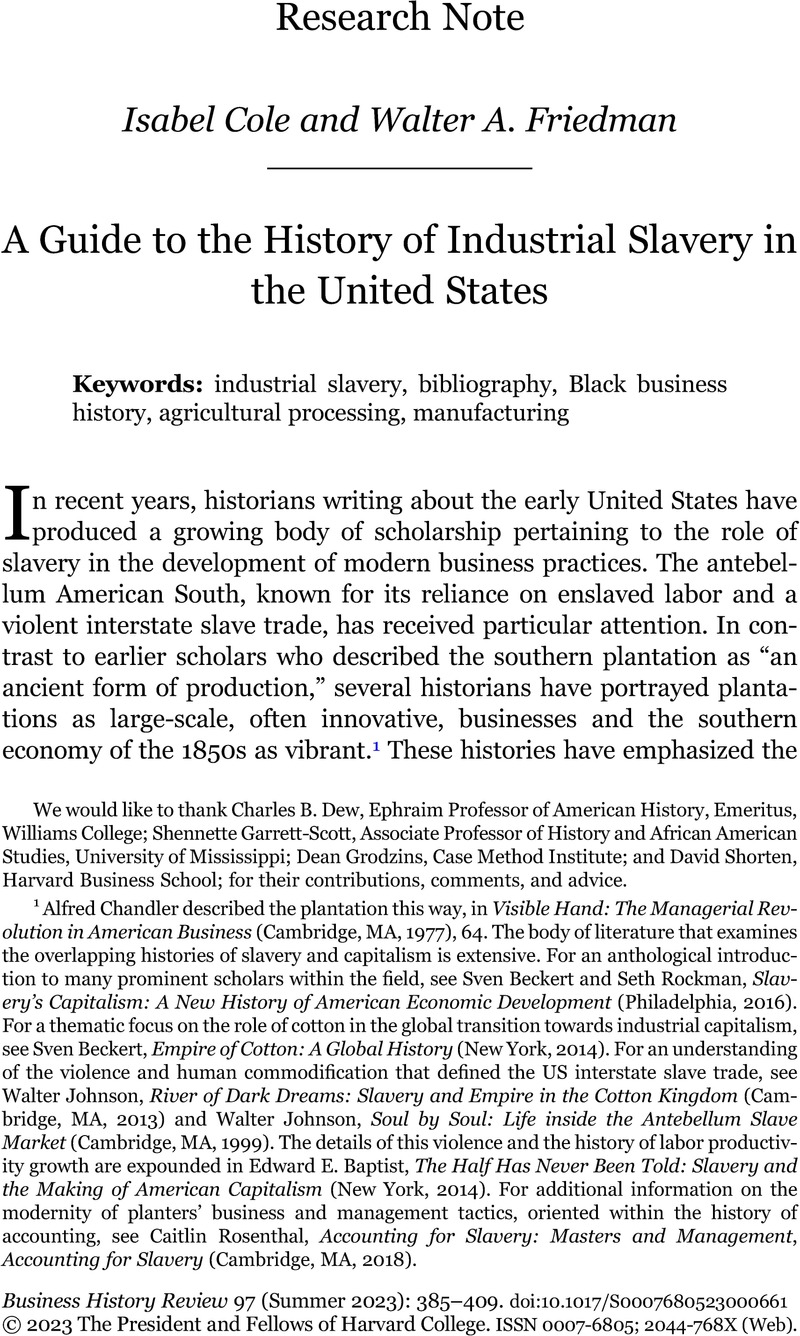No CrossRef data available.
Published online by Cambridge University Press: 25 September 2023

We would like to thank Charles B. Dew, Ephraim Professor of American History, Emeritus, Williams College; Shennette Garrett-Scott, Associate Professor of History and African American Studies, University of Mississippi; Dean Grodzins, Case Method Institute; and David Shorten, Harvard Business School; for their contributions, comments, and advice.
1 Alfred Chandler described the plantation this way, in Visible Hand: The Managerial Revolution in American Business (Cambridge, MA, 1977), 64. The body of literature that examines the overlapping histories of slavery and capitalism is extensive. For an anthological introduction to many prominent scholars within the field, see Beckert, Sven and Rockman, Seth, Slavery's Capitalism: A New History of American Economic Development (Philadelphia, 2016)CrossRefGoogle Scholar. For a thematic focus on the role of cotton in the global transition towards industrial capitalism, see Beckert, Sven, Empire of Cotton: A Global History (New York, 2014)Google Scholar. For an understanding of the violence and human commodification that defined the US interstate slave trade, see Johnson, Walter, River of Dark Dreams: Slavery and Empire in the Cotton Kingdom (Cambridge, MA, 2013)CrossRefGoogle Scholar and Johnson, Walter, Soul by Soul: Life inside the Antebellum Slave Market (Cambridge, MA, 1999)Google Scholar. The details of this violence and the history of labor productivity growth are expounded in Baptist, Edward E., The Half Has Never Been Told: Slavery and the Making of American Capitalism (New York, 2014)Google Scholar. For additional information on the modernity of planters’ business and management tactics, oriented within the history of accounting, see Rosenthal, Caitlin, Accounting for Slavery: Masters and Management, Accounting for Slavery (Cambridge, MA, 2018)CrossRefGoogle Scholar.
2 On criticism, see, for instance, Hilt, Eric, “Economic History, Historical Analysis, and the New History of Capitalism,” Journal of Economic History, 77, no. 2 (June 2017): 511–536CrossRefGoogle Scholar; and Omstead, Alan and Rhode, Paul, “Cotton, Slavery, and the New History of Capitalism,” Explorations in Economic History, 67 (Jan. 2018): 1–17CrossRefGoogle Scholar.
3 Starobin, Robert S., Industrial Slavery in the Old South (New York, 1970), 11Google Scholar.
4 Starobin, vii.
5 Starobin, 11.
6 Eaton, Clement, The Growth of Southern Civilization, 1790–1860 (New York, 1961), 242Google Scholar.
7 Norris W. Preyer, “The Historian, The Slave, and The Ante-Bellum Textile Industry,” The Journal of Negro History 46, no. 2 (Apr. 1961): 79.
8 Preyer, “The Historian, The Slave, and The Ante-Bellum Textile Industry,” 78–80.
9 Accounts of formerly enslaved people are found in Born in Slavery: Slave Narratives from the Federal Writers’ Project, 1936–1938. Library of Congress, Manuscripts Division, Washington, D.C. (https://www.loc.gov/collections/slave-narratives-from-the-federal-writers-project-1936-to-1938/). This collection contains over 2,300 first-person narratives of enslavement, and 500 photographs, collected in the 1930s as a part of the Federal Writers’ Project of the Works Progress Administration.
10 Starobin, Industrial Slavery in the Old South, 19.
11 Starobin, 17.
12 Starobin, 18–19.
13 Starobin, 15.
14 Starobin, 22–23.
15 Starobin, 23.
16 Starobin, 25–26.
17 Ronald L. Lewis, Coal, Iron, and Slaves: Industrial Slavery in Maryland and Virginia, 1715–1865 (Westport, 1979), 5.
18 Preyer, “The Historian, The Slave, and The Ante-Bellum Textile Industry,” 78–80.
19 Starobin, Industrial Slavery in the Old South, 13.
20 Starobin, 28.